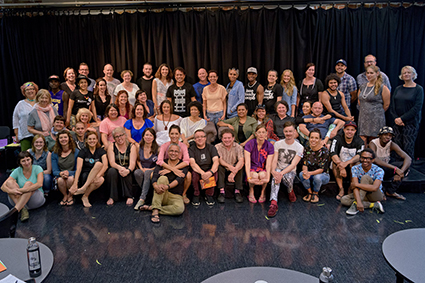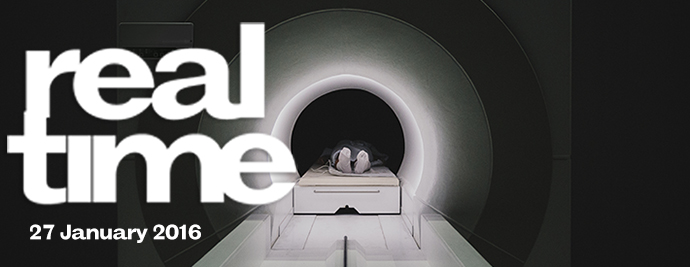 |
December 10 group shot, Dana Waranara photo Mick Roberts |
Along with a series of hotbed discussion panels, the highlight of the convergence was the pecha kucha pitches and quick dance presentations that gave a national snapshot of the cultural influences and connections to country that drive exciting myriad Indigenous dance ideas that have or will come to fruition.
What I learnt from this moving and humbling experience is that overwhelmingly Indigenous dance is an extension of our ongoing cultural practice. It is deeply personal and utterly entwined with connection to people and country. Trying to remove an Indigenous choreographer from their dance creation is impossible. It can’t be done. Indigenous choreographers create dance, not to make themselves look good or smart or marketable. Our very survival is dependent on dance. It is through dance that our stories and culture are transmitted, like a yarn, through space, on the ground and in the air. It vibrates forever.
The passion and will to dance and move is irresistible and, despite the dearth of spaces to learn and present our craft in this country, Indigenous people are integrally driven to dance and create that which has been danced and created for years.
Many Indigenous dance works fail to find the big stages, the big venues, the big festivals, but the passion and drive to create is strong. The will to dance finds the rooms, stages and stomping grounds where we can light the fire and share.
What can presenters and producers do to provide a pathway for this passionate and driven cultural and creative transmission? How can the regional art centres (many of whom once banned Aboriginal people from their venues) create a safe place for Indigenous dance and performance?
How can Indigenous choreographers compete with the national and international big shots? What are the sensitivities around marketing Indigenous dance works that have such overwhelming responsibilities to people and place? How do you balance the needs of the audience with our cultural responsibilities?
Despite these deep and seemingly divisive questions, what was most refreshing about Dana Waranara was that presenters and choreographers truly mucked in with one another. We sat as one. We sought to understand each other deeply. We listened. This wasn’t a market. We came to a deeper understanding of each other’s responsibilities—the power of space and the privilege that comes with that; and the power and responsibility of cultural transmission and how this intersects with “art.”
I saw a dancer struggle with the beautiful complexity of dancing his kinship system. I watched a woman carry the weight of a branch and generations of her culture on her shoulders. I saw tragic loss and bountiful hope. I saw mothers and fathers dance for their children. I saw a man literally dance in his dangerous and proud blood. I saw every dancer’s country—time and time again.
Some Indigenous dance works are ready to go, looking for a stage or coming to a stage near you, others are germinating and will require careful resourcing and investment.
Hopefully conversations and connections were made at Dana Waranara that will continue to water the deeply personal ideas that were delicately and passionately shared. Whatever happens, I know deep in my heart, that Indigenous dancers will always dance—either on the nation’s stages or without. They must. They will.
BlakDance & Performing Lines, Dana Waranara, An Indigenous-led convergence bringing together choreographers & presenters, Judith Wright Centre of Contemporary Arts, Brisbane, 8-10 Dec 2015, www.blakdance.org.au
Sydney-based Indigenous playwright Andrea James received the NSW Aboriginal Arts Fellowship for 2015 and is an Artistic Associate at Carriageworks. Her forthcoming work is a one-woman play about legendary Indigenous tennis champion Evonne Goolagong Cawley.
See also Vicki Van Hout, Angharad Wynne-Jones and Liza-Mare Syron’s responses to Dana Waranara. The articles by James, Syron and Wynne-Jones were commissioned by BlakDance.
© Andrea James; for permission to reproduce apply to [email protected]








 back
back